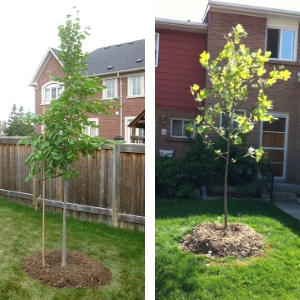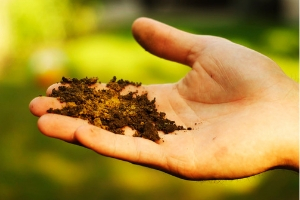
Planting in the front yard vs. the backyard
Start by assessing your property and thinking about how you use the space. Remember that urban trees often face harsh growing conditions, especially in front yards and close to the street. In an urban and suburban setting, backyards provide ideal tree planting locations. Why?
- Backyards generally have higher soil volume and better soil quality than front yards
- Backyard trees are more protected from salt, vandalism and physical damage
- Conflicts with underground and overhead utilities are less common in backyards
LEAF staff will only plant in backyards since property line determination and underground utility locates are much less complicated. But, homeowners looking to plant in their front or side yards can do so through our Do-It-Yourself program. We provide species and location advice and deliver the trees to you, but it will be your responsibility to plant and to “call before you dig!”
Choosing the right location:
When assessing your yard to determine the best planting location, consider:
- Existing structures, such as decks, patios, driveways, other hard surfaces, buildings (with and without foundations), other structures, underground and overhead utilities, etc.
- Existing trees in your yard or neighbouring yards that might compete for resources like sunlight, ground space for root growth, soil nutrients, and water.
It is important to ensure that the planting location you have in mind is far enough away from any existing structures or trees. Your new tree will need lots of space to grow and thrive! At LEAF, we recommend the following spacing.

Once you have selected where to plant, the next step is to assess the environmental conditions of the location:
- Sunlight exposure: Consider the amount of direct sunlight at the location. Is there sunlight for six or more hours? For less than two hours? Are there structures and trees shading the area? This will dictate if the location has full sun, partial sun or shade.
- Soil type: Note the colour of the soil and how it feels in your hand. Is it easy to dig through? Does it fall apart easily in your hand? Does the planting area often have standing water? These observations will help you identify if your soil is sandy loam or compact, dense clay.
Just like humans, trees have preferences. In order for a newly planted tree to grow into a healthy, mature tree, it should be planted in a location with environmental conditions similar to its natural range. We recommend choosing a species that is well suited for the conditions of your yard instead of trying to modify your yard to suit an incompatible species.
Choosing the right species
The best way to choose a species among those suited for your yard is to determine the purpose of the tree. Answering the following questions should help: What height do you want your tree to reach at maturity? Are you seeking shade or privacy? Do you want a tree that will provide food and habitat for wildlife? What kind of characteristics are you looking for in a tree: fall colour, flowers, interesting foliage or bark, etc.?

At LEAF, we encourage property owners to plant native! Native trees are naturally adapted to our local environmental conditions. Once established, they tend to be hardier than exotic species. They also enhance local biodiversity by providing habitat and food for native wildlife!
Planting the right tree in the right place requires some research, but it’s ultimately a very rewarding investment! There’s nothing wrong with needing a little help. And, we’re happy to walk you through it – every step of the way! Our certified arborists consult with the property owner to assess the yard, choose the right species, select the correct planting location and deliver or plant the trees (depending on the program). The LEAF Backyard Tree Planting Program is designed to make planting native trees and shrubs easy and affordable!
Natasha Keshavjee is an ISA Certified Arborist and the Residential Planting Programs Coordinator at LEAF.
The Backyard Tree Planting Program is supported by the City of Toronto, the Regional Municipality of York, the City of Markham, the Town of Newmarket, the Town of Ajax, Toronto Hydro and Ontario Power Generation.
